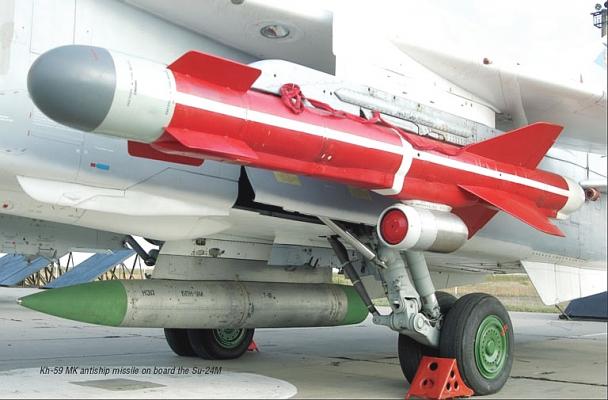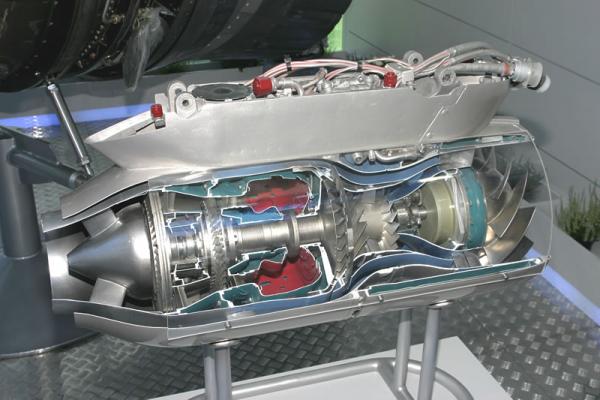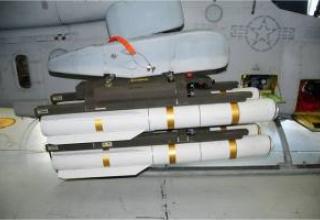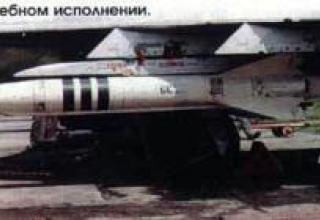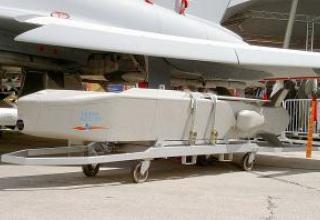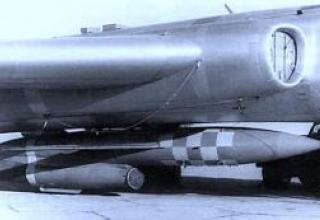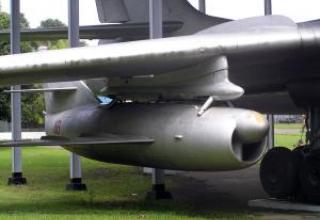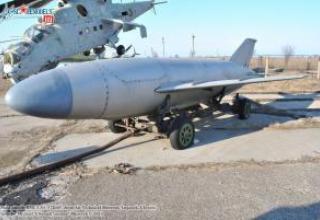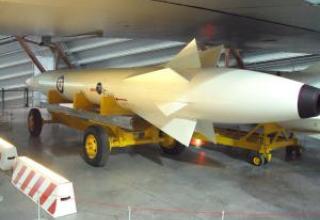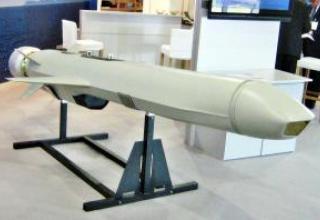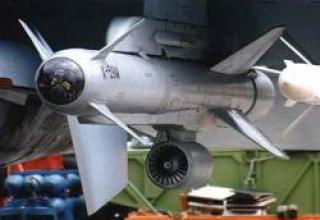The X-59MK long-range guided air-to-surface missile with an active homing radar head is a modification of the X-59M missile and is intended to engage a wide range of radar-contrast surface targets at any time of day, both in simple and difficult weather conditions with sea waves up to 6 points. Group use of missiles is provided.
Developer - FSUE ICB "Raduga" (Dubna, Moscow region). X-59MK was first demonstrated at the International Air Show MAKS-2001. The missile is part of the armament of Su-30 type aircraft systems.
Kh-59MK2 multi-purpose missile (see photo) is a modification of Kh-59MK and is intended to engage a wide range of fixed ground targets with known location coordinates, including those without radar, infrared and optical contrast to the surrounding background.
Composition:
Like all Kh-59 family rockets, Kh-59MK rocket is made on the "tailless" scheme and is equipped with a cross-shaped triangular wing (see diagram). Four destabilizers are installed in the nose section of the hull. Compared with the X-59M missile has a new control system and a marching engine. Replacing the launch accelerator with an additional fuel tank has significantly increased the range of the missile (see diagram).
X-59MK is used to engage a wide range of surface radar-contrast targets with EPR more than 300 m2 (from a boat to a cruiser) at any time of day, both in simple and difficult weather conditions in the open sea and near the shoreline. The maximum range of the X-59MK missile for the destroyer-cruiser target is 285 km, for the boat target - 145 km (see the area of engagement). According to the developer's estimation, the probability of hitting the cruiser or destroyer is 0.9-0.96, and the probability of hitting the boat is 0.7-0.93. Thus, one missile is enough to hit the boat, and the estimated average number of hits to destroy the cruiser or destroyer is 1.8 and 1.3, respectively.
PKR X-59MK is equipped with an active radar homing head ARGS-59E, which in combination with modern noise-protected control system and a powerful BC provides high efficiency of combat application. The ARS-59E has been developed at the "Radar MMS" Research and Production Enterprise, OJSC. (St. Petersburg). The maximum range of detection of ARGS of "destroyer" type target (EEP>5000kv.m) -25km, "boat" type target (EEP>300kv.m) -15km. Angle of pumping ARGS antenna on azimuth - ±45 °, on a place corner - +10 ° ... -20 °. The missile is capable of performing complex flight trajectories with bypassing hazardous areas and all-around approach to the target (see diagram). The missile can be used in groups.
The X-59MK2 missile (see photo1, photo2) differs from the X-59MK by its correlation-optical homing head, which provides autonomous recognition of the area adjacent to the target. It is equipped with a navigation and automatic control system based on a free inertial navigation system and complemented by a satellite correction unit. The Kh-59MK (Kh-59MK2) missile control systems include the A-079E radio altimeter developed by the Detal Design Bureau. The low-altitude flight route to the target is specified in the flight task. Thus the missile's flight altitude above the ground surface (depending on the terrain relief) is only 50...300 m, which makes it extremely difficult to intercept air defense systems on the ground. The final homing system provides a circular probable deviation from a given point, which does not exceed 3 ... 5 m. The X-59MK2 missile can be used at any time of year, with illumination of 103 ÷ 105 lux above any type of terrain. Target angle at launch of X-59MK2 missile is up to ±45°.
The penetrating combat unit (PFC) weighing 320 kg (see photo) has a time delay fuse. The dimensions of the BMP are: diameter -380 mm, length -131 mm. The X-59MK2 missile can be equipped with a 283 kg cassette warhead (CBM) with shrapnel and cumulative effects.
Kh-59MK and Kh-59MK2 missiles are equipped with the highly economical low-resource 36MT turbojet engine. The 36MT engine (TRDD-50AT) was developed by the Omsk Engine Design Bureau (OJSC OMKB) and produced by NPO Saturn.
Turbojet engine 36MT of pylon version is double-circuit, twin-shaft, with coaxial shafts of low and high pressure cascades. Combustion chamber - ring semi-finished with rotating nozzle. High pressure cascade - axial compressor and single stage axial turbine, low pressure cascade - single stage fan with wide chord blades and single stage axial turbine.
The 36MT develops a static take-off thrust of 450 kgs at sea level with its own dry weight of 82 kgs, has a maximum cross-section size of 330 mm and length of 850 mm. Specific fuel consumption at maximum mode is 0.71 kg/kgf*h. The fuel used is T-1 (aviation kerosene), T-6, T-10 (decylin), TS-1, RT.
The engine operates in a fairly wide flight range with the ability to maneuver in height and speed (flight height from 0.2 to 11 km, flight speed up to 1100 km/h). To perform the flight program and regulation, 36MT is equipped with a modern electronic-hydraulic control system and a built-in 4 kW electric generator. The engine has an autonomous oil system.
Operating features of the 36MT engine:
- High fuel efficiency.
- Resistant to ingress of small foreign objects (birds, dust, etc.).
- Resistant to shock and heat waves.
- Ability to spontaneously escape from a pump after the cause of its disappearance.
- Reliable start in the whole range of external operating conditions (from +60° C to -50° C).
- High receptivity.
For the control of Kh-59MK missiles during their routine maintenance, an automated system for control of ASCs from the OSA complex is used, which was modified to control Kh-59MK missiles. SNO-106MA ground handling equipment is used to ensure the operation of missiles under conditions of technical position, transportation, storage in arsenals and warehouses, performing routine maintenance, inspection of missiles and their issuance for suspension under the carrier aircraft.
Set of delivery:
- combat version - X-59MK missile;
- Kh-59MK (UR) training and cutting version;
- Kh-59MK (UD) training and operational version;
- automated control system;
- ground handling equipment for Kh-59MK;
- Kh-59MK group missile instrumentation package;
- a set of operational documentation for the group missile.
Characteristics:
| Х-59МК | Х-59МК2 | |
| Maximum range, km: | 285 | |
| Minimum range, km | 5…25 | |
| Missile launch modes: - launch speed range of the launch vehicle, km/h - number range M range of launch flight - range of altitudes of the carrier, km - target angle at launch, deg |
600...1100 0,5…0,9 0,2…11 -45...+45 |
|
| Rocket speed, km/h. | 900…1050 | |
| The flight altitude of the rocket, m: - on the march - near the target |
10…15 4…7 |
50…300 |
| Missile launch weight, kg | not more than 930 | not more than 900 |
| Weight of combat unit, kg | 320 -FFrequency | 320 - PPBh 283 - KBH |
| Dimensions, m: - body length - wingspan - main body/bow diameter |
5,7 1,3 0,38 / 0,42 |
|
| Time to prepare for launch from duty, s | 15 | |
| Maximum time on the carrier suspension of the aircraft in standby mode, 24 hours | 30 | |
Testing:
The first launches of K-10 in marine aviation were made by North Sea crews on the Caspian Sea in July 1960. Having departed from the airfield of the 33rd Center near Nikolaev, a pair of Tu-16K-10s reached the target, and from a height of 10,000 m at a range of 175 km the crew of Colonel Myznikov made the launch. Due to a pointing error, the missile did not reach the target, having fallen into the sea at 40 km, the crew of Lieutenant Colonel Kovalev, who followed, attacked from a distance of 170 km, achieving a direct fall into the target - the tanker "Chkalov" drowned in shallow water. Within two weeks, three more attacks were carried out, one of which again failed due to operator's error, and in one missile hit the crest of the wave just 200 m from the ship.
The training and combat launches were accompanied by supervision of industry representatives - nevertheless, the system was accepted with many reservations and required prompt correction of defects. For this purpose, even a special design and technological bureau (SCTB) was organized with participation of engineers from MAP, Design Bureau, Research Institute and AUMF. The researches carried out on the basis of the 33rd Center showed the practical feasibility of target detection from 450 km by adjusting the frequencies and length of the radar pulses. It was possible to launch long-range missiles from 325 km, and the lower limit of the aircraft flight was 500-600 m. The radar antenna of the carrier carried out scanning, mechanically rotating through the azimuth of 120 °, making it possible to turn away from the target after launch and continue to provide escort. Usually, the turn-off was performed at the 100th second with a roll of 9-12°, dictated by the possibility of stabilization of the antenna. Approximation to the target, depending on the flight mode and altitude of the launch, did not exceed 140-160 km (later withdrawal from the attack at the start of K-10SD from the maximum range could be carried out at a distance of 265 km).
In one of the departures for tactical launch in 1961, the crew of Captain G.A.Zimin faced an emergency situation, when the missile released into the starting position could not be returned. Nothing good landed with a hanging missile did not promise, because with a normal landing angle of 8 °, there was a great risk of "combing" the missile on the ground. Nevertheless, the crew managed to get the plane to land successfully, and then the instructions for such a case were introduced in the pilot's instructions.
In 1960-62, the K-10 missile system was equipped with seven air regiments of all Soviet fleets: 2nd MRAD of the Black Sea, 5th MRAD of the North, 25th and 143rd MRAD of the Pacific and 57th MRAD of the Red Banner Baltic Fleet. The intensity of development and combat training of maritime aviation crews looked impressive: for the first six months of operation in 1960 there were 79 launches, the next - 126, and in 1962 - 147 (however, the reverse side was a large consumption of combat missiles, and a duplicate aircraft like "Kometa", which allows you to save money and expensive products, for the K-10 was not available).
Another shortcoming was revealed - poor preparedness of ground services for operation of complex equipment. At first, it was assigned to a special engineering and aviation service of SIS, and the issues of warehousing, engaged in repair and maintenance base. Getting rid of duplication of work, the structure was reorganized and introduced a division of responsibilities: all systems of the aircraft were serviced by IAS specialists regiment, and the full list of work on missiles was carried out by the maintenance base.
The measures taken allowed reducing the time of equipment preparation and improving the quality of work. The confirmation was the reduction of the number of unsuccessful launches due to mistakes in the preparation of the mattress - already in 1962, their number decreased by 20%. Near the aircraft were equipped with shelters, where there were refueled and equipped with missiles, pre-tested and flying in the air on "its" carrier. The procedure of suspension and preparation of K-10 was reduced to 45 minutes, and this work was fully carried out by regimental technicians and crews - preparation for the departure of two squadrons with 16 Tu-16K-10 reduced in time by half.
We managed to reduce the number of failures, although the number of complaints about the shortcomings and defects of the system remained tangible, so the reliability of the Tu-16K-10 was inferior to other, simpler complexes, primarily through the fault of the equipment. In 1961, almost half of the completed launches failed, and about a third - due to design and manufacturing flaws.
Face-to-face with Soviet missile carriers, the United NATO Fleet had to meet in September 1964 during a major exercise "Tim Work-64", covering the entire North Atlantic. More than half a dozen ships, including two aircraft carrier groups, participated. The squadron was discovered by Tu-95 reconnaissance aircraft of the Northern Fleet, after which the command of the 5th MRAD offered to organize a response exercise with the use of aviation "on real targets", showing, for example, the head of the country to the Americans "Kuzkinu mother". Command of the Navy, however, was afraid of bringing the situation to the brink of unleashing a real war, but the top leadership of the country gave the conceived "good".
By order of the Air Force Headquarters of the NF plan was adopted for implementation. In the evening of September 21, three squadrons of Tu-16K-10 strike team of Lieutenant Colonel KL Timakov, as well as scouts, designators and interference operators who were covering the missile carriers. The ship's group was found in the ocean, the planes at low altitude stealthily reached the border of the attack. The "missile strike" was launched from three directions with a distance of 160-200 km, and the enemy was helpless to repel it.
At TOF in 1964 there was a case of attack K-10S Japanese ship, which was in the restricted zone of the range. Shino-Maru" was held near Cape Tyk, where the crew of Tu-16K-10 from the 169th MRAP worked out a training task. Having refocused, the rocket went exactly on a new "target". The Japanese were lucky - the fuse was set to detonate on the trajectory to save the targets, and the explosion occurred 400 meters from the board. The wreckage damaged the superstructure and the rocket's engine broke through the ship. Among the crew were wounded, which forced the Japanese to go to the nearest Soviet port of Kholmsk for medical care and repair. The incident managed to jam, and the Japanese side believed that the ship was hit by a crashed Soviet fighter, and expressed sympathy for the lost pilot.
During the largest strategic exercise "Ocean", held in April 1970 and covering all the fleets and water areas, the North Sea Tu-16K carried out 6 rocket launches at the range, thrown into reinforcements to them 10 missile carriers with TOF April 20 attacked the target missiles near the Kola Peninsula. Nine Tu-16K-10 of the Pacific 143rd MRAD, supported by five tankers, carried out tactical attacks in the Sea of Japan, using groups of NATO and U.S. ships as targets.
The Baltfleet's Tu-16K-10 was airborne when it intercepted the mutinous SCR "Storozheva," which left the base and headed for the Strait of Irben during the October 1975 holidays. It was supposed that he wanted to go abroad, and to stop this attempt on November 8 and 9 all forces of the fleet and aviation were alerted. Rocket attack in the area with busy shipping, fortunately, did not take place - Tu-16 found the target when the ship has already been bombed and stalled cars, but they accompanied him on the way back to the base.
With the organization of the base of the Soviet fleet in the Vietnamese port of Kamran there was placed 169th gv. SAP, which, in addition to scouts, target designation and anti-submarine aircraft, at the front positions was a squadron of Tu-16K-10-26. They served there from 1982 to 1989.
Sources:
- Авиационная управляемая ракета Х-59МК /ОАО "Корпорация Тактическое Ракетное Вооружение"/
- Авиационная управляемая ракета Х-59МК2 /ОАО "Корпорация Тактическое Ракетное Вооружение"/
- Малоразмерные двигатели изд. 36МТ/37 /НПО "Сатурн"/
- Модернизация УРвп Х-59М /missiles.ru/
- Радиовысотомеры УПКБ "Деталь"
- Х-59МК Ракета повышенной дальности /Рекламный проспект ОАО ГосМКБ "Радуга"/
